How to Punctuate Dialogue – Rules & Examples (Worksheet)
| Danielle McLeod
| Punctuation
Danielle McLeod
Danielle McLeod is a highly qualified secondary English Language Arts Instructor who brings a diverse educational background to her classroom. With degrees in science, English, and literacy, she has worked to create cross-curricular materials to bridge learning gaps and help students focus on effective writing and speech techniques. Currently working as a dual credit technical writing instructor at a Career and Technical Education Center, her curriculum development surrounds student focus on effective communication for future career choices.
I’m an avid reader, and I never think twice about the punctuation that makes dialog so easy to read, allowing you to flow from one conversation to the next. With so much exposure to the technique, you’d think it would be easy to reproduce – but nothing could be further from the truth.
Punctuating dialogue properly eludes even the most voracious reader. And, it’s truly no surprise since you must remember more than one rule concerning quotations, terminal marks, and comma use when all mashed together.
Knowing how to punctuate dialogue correctly is important to help develop your characters and make them more interesting to your reader. Take a look at our dialog writing tips to help you develop your storyline for a more exciting read.

The Importance of Well-Written Dialog
Writers depend upon dialog to help bring their characters to life and allow readers to form relationships with the story they are immersed in. Good dialog punctuation helps create flow and clarity, lends tone to the sentences being spoken, and creates connections between characters and the overall storyline.
Poorly constructed sentences that feel wooden and stiff are common mistakes writers make when new to the technique. But, with practice and knowledge of strong dialog sentence structure, it doesn’t take long for them to become more confident writers.
The Rules of Dialog Writing

To avoid errors in dialogue punctuation, you must keep some precise rules in mind.
A good story uses direct and indirect dialogue between characters and dialogue with narration to enhance the storyline. This creates lines of text that can quickly become confusing when punctuation or grammar is ignored or, worse yet – used incorrectly.
Review these ten rules for punctuating dialogue to help create captivating dialogue that draws your reader into an original storyline.
Rule #1: Direct Speech Requires Double Quotation Marks
If you are in the US, you use the double closing quotation marks to indicate spoken, direct dialogue. This is the first step in punctuating dialogue correctly.
For example:
- “Mom, Sanna and I only went to the store, and we came right back!” exclaimed Sarah.
- Maxine wasn’t so sure, asking, “If I spoke to Mr. Hooper, would he tell me he saw you there?”
British or Commonwealth English uses a single quotation mark, but both styles indicate the same thing.
This article focuses on the American English standard widely accepted by the Chicago Style Manual to avoid confusion.
Rule #2: Periods (and Other End Marks) Belong Inside Quotation Mark
Misplaced periods and other end marks are common mistakes when writing dialogue. Complete spoken sentences should always end with the end mark inside the quotation marks.
- She reviewed the essay, stating, “You’ll need to proofread for corrections.”
- She watched the light turn green and, glancing sideways, said, “What if we kept driving and just didn’t stop?”
Rule #3: Comma Placement is Dictated by Speaker Attribution
The majority of written dialogue is attributed to a speaker using dialogue tags. This helps a reader keep track of who is speaking, especially when back-and-forth dialog is used between two or more characters.
An attribute is a simple way to give credit to a speaker. These can be as simple as she said or he replied . They can also be more detailed, providing tone or behavioral hints, such as she rolled her eyes, leaned forward, and whispered .
When the attribute comes before the dialogue, place the comma outside the quotation marks.
- She exclaimed, “There is no way I will be involved with that plan.”
- He wasn’t impressed, looked her in the eyes, and stated, “You promised to take part in this all.”
When the attribute comes after dialogue, you place the comma inside the quotation marks.
- “I’m heading to the store,” Sarah told her mother.
- “Go straight there and back,” was the reply.
Rule #4: Always Begin New Sentences with a Capitalization
Dialogue dictates that new sentences always begin with capitalization, even when following an attribute. This may be slightly different than other rules of quotation use, but it is important to help highlight the speech of your characters.
- She turned to him smiling and spoke her thoughts aloud, “If I were to leave, what would you do?”
Do not capitalize dialog that follows an interrupting attribute.
- He smiled back, “I’d follow you,” he replied, “anywhere you go.”
Rule #5: Start a New Paragraph Each Time the Speaker Changes
One of the most important rules of organizing dialogue is to begin a new paragraph each time the speaker changes. This provides a visual of who is speaking and is especially important to avoid the overuse of attributes during back-and-forth dialogue.
To indicate a new paragraph, leave a space between each line.
“Why are you here so early?” asked the teacher, looking down on the little blond head riddled with cowlicks.
The student looked up at her, blinking, “I need to study for my test today, and our power was out at the house.”
“Oh no! Of course, you can study here. I was just going to make some coffee. Would you like some cocoa to help get focused?”
“Yes. Thank you!”
“No problem. You can study early anytime you need to. I’m almost always here by this time.” She walked into the lounge, shaking her head, knowing he wasn’t the only student that needed a warm, lighted place to start the day in.
Rule #6: Use Action Beats to Replace Dialogue Tags
Dialogue tags can become very monotonous in their use and take away from the tone of what is being said when overused. Consider using action beats that describe what the character is doing while they are speaking to help add detail and action to your dialogue.
Dialogue punctuation rules stay the same with action beats.
“Hmmmmm.” He rubbed his chin and glanced at the clock. “I’m just as confused as you are, but at the moment, I don’t have time to think about it.” He stood up, ushering the children towards the door. “Come back tomorrow when we can discuss this further.”
“But, tomorrow will be too late!” The children turned away from the door. “By then, she could be gone altogether!”
Rule #7: Avoid Closing Quotations Between Paragraphs of Speech
When a character speaks more than a few sentences in a row, you can split their extended speech up into multiple individual paragraphs. When you do this, you indicate to the reader the speech is not over by omitting the closing punctuation marks.
Still provide open quotation marks at the start of the new paragraph.
“It wasn’t difficult for me to find out what you all had been up to last night.” His mother looked them over, “I had the porch camera on, and it triggered the garage light. When I saw that come on, I knew somebody had to be coming in through the back to avoid waking me up. What you didn’t know was I was already awake.
“Although I didn’t say anything at the time, I checked with Mark’s mother this morning, and she let me know he had told her he was staying over here.” She wasn’t happy, and he knew he was in for it.
She continued on, “You told me you were staying at Mark’s house. So, of course, I wanted to know what you both were hiding from us.
“When I saw that you had the cellar door cracked open, I knew where you had to be keeping her.” She paused, “James, I told you we couldn’t afford to feed another dog, and now she’s down there with her puppies. What did you do that night? Go out to the tracks and carry them all back here thinking I would never notice?”
He nodded, “But, mom…” and looked up at her, “they would have died if we left them out there.”
Rule #8: Use Em-Dashes and Ellipses to Interrupt Speech
If you need to indicate an interruption in dialogue due to being cut off or a pause in speech, then you will use an em-dash or ellipses within the quotation marks.
“I know you care a lot about him, but — “
She interrupted, “You don’t understand that he’s just a friend!”
“— you aren’t going to camp with him this summer.” Her father finished.
“Listen, I just need to know what is going on…” she looked at her beseechingly.
Jen sighed, “I’ll explain it all one day. I just can’t right now.”
Rule #9: Use Single Quotes When Your Character is Quoting Someone or Something
If you are wondering how to use quotation marks within the dialogue to indicate a character directly quoting another, you need to use single quotation marks. A dialogue with quotes within it specifically highlights the thoughts or words of another person.
“Tell me what the professor said was going to be on the test again.”
“He said the test would last 2 hours and to ‘read through the first two chapters, review all the vocabulary, and be able to explain the photosynthesis process.’”
Rule #10: Use Italics for Thoughts and Internal Monologues
Avoid using quotations for internal dialogue and monologues. Although, as an author, you can take artistic license and choose to use quotations, it is generally accepted to use italics in this manner if your text also includes spoken dialogue to avoid confusing the two. Just be sure to be consistent with their use.
The kitten sat at the window, eyes big and begging to be let inside.
Kimberly knew her mother would be mad, but, What she doesn’t find out won’t kill her , she thought as she opened the window.
Let’s Review
Writing dialog punctuation isn’t as tricky as it may seem at first as long as you follow these dialogue example rules. End marks, commas, and quotation marks in a dialog should be kept consistent in their use to provide clarity and flow to written conversation.
Always enclose dialog in double quotation marks, using single quotation marks to indicate a quote spoken by a character. End parks belong inside the quotations, while comma placement is determined by speaker attribution.
Grammarist is a participant in the Amazon Services LLC Associates Program, an affiliate advertising program designed to provide a means for sites to earn advertising fees by advertising and linking to Amazon.com. When you buy via the links on our site, we may earn an affiliate commission at no cost to you.
2024 © Grammarist, a Found First Marketing company. All rights reserved.
TRY OUR FREE APP
Write your book in Reedsy Studio. Try the beloved writing app for free today.
Craft your masterpiece in Reedsy Studio
Plan, write, edit, and format your book in our free app made for authors.

Guides • Perfecting your Craft
Last updated on Jul 24, 2023
6 Unbreakable Dialogue Punctuation Rules All Writers Must Know
Dialogue punctuation is a critical part of written speech that allows readers to understand when characters start and stop speaking. By following the proper punctuation rules — for example, that punctuation marks almost always fall within the quotation marks — a writer can ensure that their characters’ voices flow off the page with minimal distraction.
This post’ll show you how to format your dialogue to publishing standards.
6 essential dialogue punctuation rules:
1. Always put commas and periods inside the quote
2. use double quote marks for dialogue (if you’re in america), 3. start a new paragraph every time the speaker changes , 4. use dashes and ellipses to cut sentences off, 5. deploy single quote marks used for quotes within dialogue, 6. don’t use end quotes between paragraphs of speech .
The misplacement of periods and commas is the most common mistake writers make when punctuating dialogue. But it’s pretty simple, once you get the hang of it. You should always have the period inside the quote when completing a spoken sentence.
Example: “It’s time to pay the piper.”
As you’ll know, the most common way to indicate speech is to write dialogue in quotation marks and attribute it to a speaker with dialogue tags, such as he said , she said, or Margaret replied, or chirped Hiroko . This is what we call “attribution” when you're punctuating dialogue.
Insert a comma inside the quotation marks when the speaker is attributed after the dialogue.
Example: “Come closer so I can see you,” said the old man.
If the speaker is attributed before the dialogue, there is a comma outside the quotation marks.
Example: Aleela whimpered, “I don’t want to. I’m scared.”
If the utterance (to use a fancy linguistics term for dialogue 🤓) ends in a question mark or exclamation point, they would also be placed inside the quotation marks.

Exception: When it’s not direct dialogue.
You might see editors occasionally place a period outside the quotation marks. In those cases, the period is not used for spoken dialogue but for quoting sentence fragments, or perhaps when styling the title of a short story.
Mark’s favorite short story was “The Gift of the Magi”.
My father forced us to go camping, insisting that it would “build character”.

Now that we’ve covered the #1 rule of dialogue punctuation, let’s dig into some of the more nuanced points.
In American English, direct speech is normally represented with double quotation marks.
Example : “Hey, Billy! I’m driving to the drug store for a soda and Charleston Chew. Wanna come?” said Chad
In British and Commonwealth English, single quotation marks are the standard.
Example: ‘I say, old bean,’ the wicketkeeper said, ‘Thomas really hit us for six. Let’s pull up stumps and retire to the pavilion for tea.’
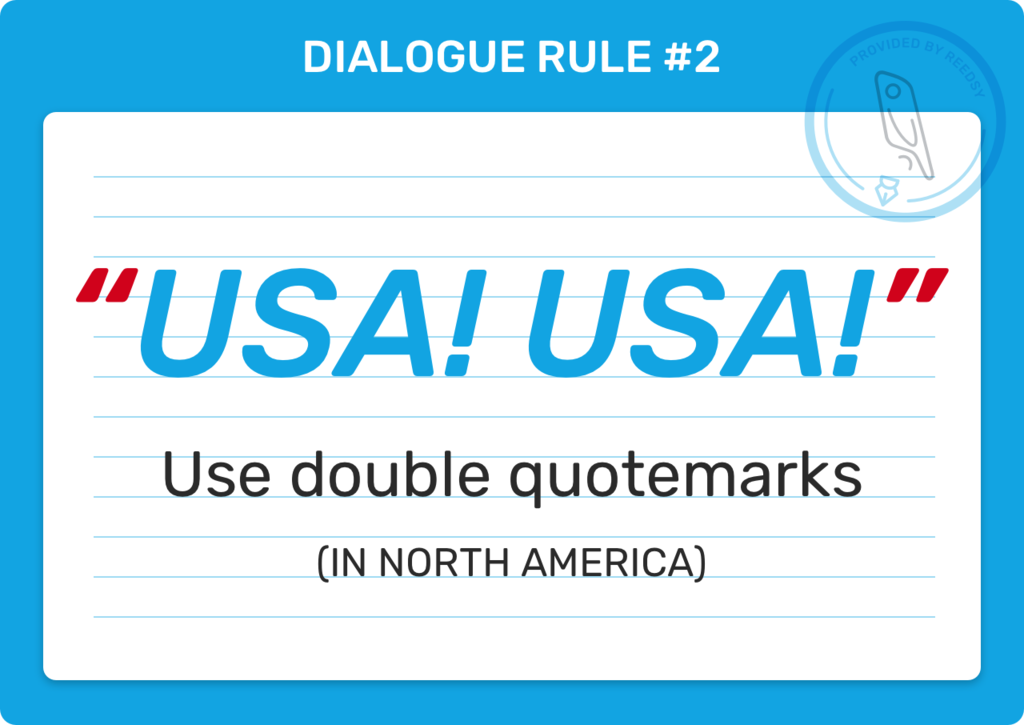
This is one of the most fundamental rules of organizing dialogue. To make it easier for readers to follow what’s happening, start a new paragraph every time the speaker changes, even if you use dialogue tags.
“What do you think you’re doing?” asked the policeman. “Oh, nothing, officer. Just looking for my hat,” I replied.
The new paragraph doesn’t always have to start with direct quotes. Whenever the focus moves from one speaker to the other, that’s when you start a new paragraph. Here’s an alternative to the example above:
“What do you think you’re doing?” asked the policeman. I scrambled for an answer. “Oh, nothing, officer. Just looking for my hat.”

FREE COURSE
How to Write Believable Dialogue
Master the art of dialogue in 10 five-minute lessons.
So far, all of the examples we’ve shown you are of characters speaking in full, complete sentences. But as we all know, people don’t always get to the end of their thoughts before their either trail off or are interrupted by others. Here’s how you can show that on the page.
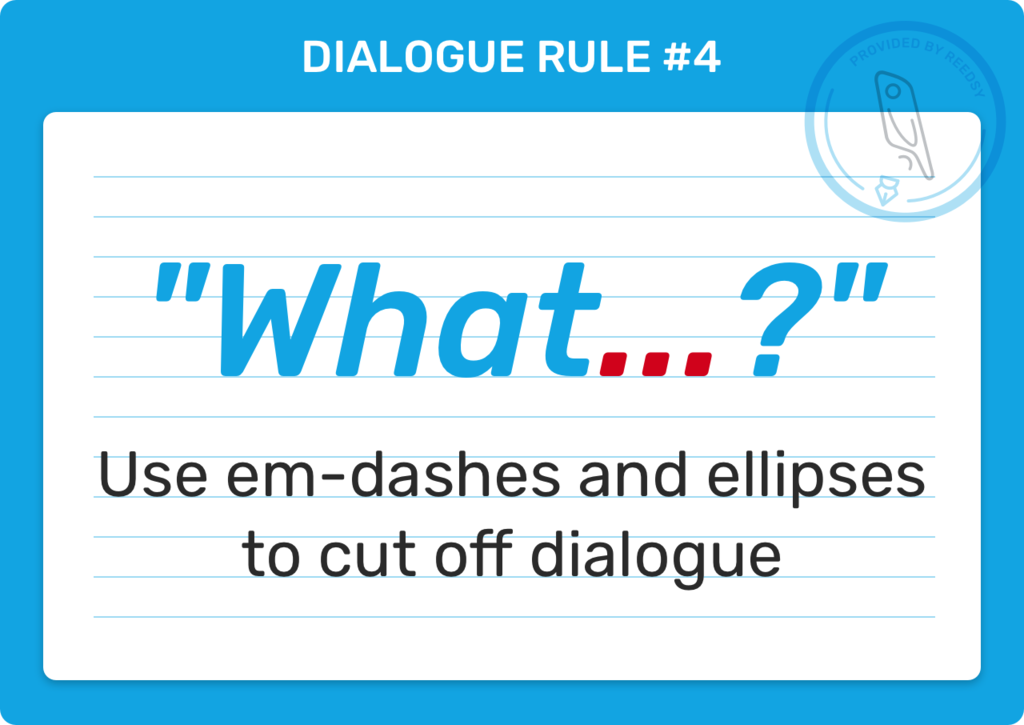
Em-dashes to interrupt
When a speaking character is cut off, either by another person or a sudden event, use an em-dash inside the quotation marks. These are the longest dashes and can be typed by hitting alt-shift-dash on your keyboard (or option-shift-dash for Mac users).
“Captain, we only have twenty seconds before—” A deafening explosion ripped through the ship’s hull. It was already too late.
“Ali, please tell me what’s going—” “There’s no use talking!” he barked.
You can also overlap dialogue to show one character speaking over another.
Mathieu put his feet up as the lecturer continued. "Current estimates indicate that a human mission will land on Mars within the next decade—" "Fat chance." "—with colonization efforts following soon thereafter."
Sometime people won’t finish their sentences, and it’s not because they’ve been interrupted. If this is the case, you’ll want to…
Trail off with ellipses
You can indicate the speaker trailing off with ellipses (. . .) inside the quotation marks.
Velasquez patted each of her pockets. “I swear I had my keys . . .”
Ellipses can also suggest a small pause between two people speaking.
Dawei was in shock. “I can’t believe it . . .” “Yeah, me neither,” Lan Lan whispered.
💡Pro tip: The Chicago Manual of Style requires a space between each period of the ellipses. Most word processors will automatically detect the dot-dot-dot and re-style them for you — but if you want to be exact, manually enter the spaces in between the three periods.
In the course of natural speech, people will often directly quote what other people have said. If this is the case, use single quotation marks within the doubles and follow the usual rules of punctuating dialogue.
“What did Randy say to you?” Beattie asked. “He told me, ‘I got a surprise for you,’ and then he life. Strange, huh?”
But what if a character is quoting another person, who is also quoting another person? In complex cases like this (which thankfully aren’t that common), you will alternate double quotation marks with single quotes.
“I asked Gennadi if he thinks I’m getting the promotion and he said, ‘The boss pulled me aside and asked, “Is Sergei going planning to stay on next year?”’”
The punctuation at the end is a double quote mark, followed by a single quote mark, followed by another double quote. It closes off:
- What the boss said,
- What Gennadi said, and
- What Sergei, the speaker, said.
Quoting quotes within quotes can get messy, so consider focusing on indirect speech. Simply relate the gist of what someone said:
“I pressed Gennadi on my promotion. He said the boss pulled him aside and asked him if I was leaving next year.”

In all the examples above, each character has said fewer than 10 or 20 words at a time. But if a character speaks more than a few sentences at a time, to deliver a speech for example, you can split their speech into multiple paragraphs. To do this:
- Start each subsequent paragraph with an opening quotation mark; and
- ONLY use a closing quotation mark on the final paragraph.
"Would you like to hear my plan?" the professor said, lighting his oak pipe with a match. "The first stage involves undermining the dean's credibility: a small student protesst here, a little harassment rumor there. It all starts to add up. "Stage two involves the board of trustees, with whom I've been ingratiating myself for the past two semesters."
Notice how the first paragraph doesn't end with an end quote? This indicates that the same person is speaking in the next paragraph. You can always break up any extended speech with action beats to avoid pages and pages of uninterrupted monologue.
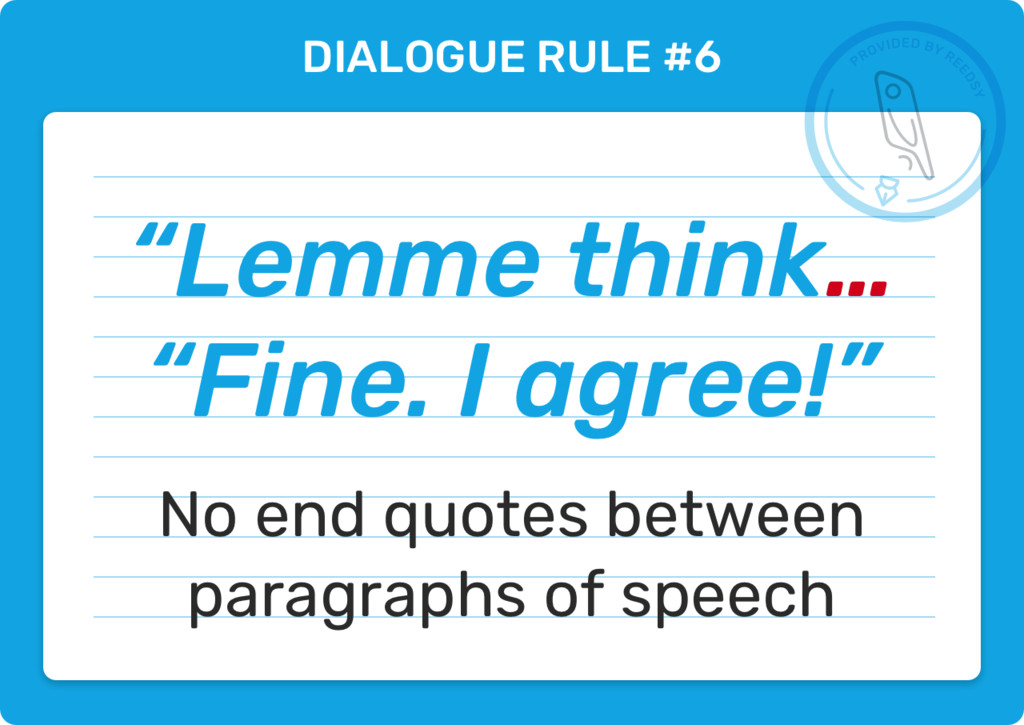
Want to see a great example of action beats breaking up a monologue? Check out this example from Sherlock Holmes.
Hopefully, these guidelines have clarified a few things about punctuating dialogue. In the next parts of this guide, you’ll see these rules in action as we dive into dialogue tags and look at some more dialogue examples here .
Join a community of over 1 million authors
Reedsy is more than just a blog. Become a member today to discover how we can help you publish a beautiful book.

We made a writing app for you
Yes, you! Write. Format. Export for ebook and print. 100% free, always.

1 million authors trust the professionals on Reedsy. Come meet them.
Enter your email or get started with a social account:

How To Punctuate Dialogue: 11 Rules To Write It Like A Pro
Writing a good story is hard enough without having to worry about your dialogue punctuation .
Our goal in this post is to answer any questions you might have about punctuating dialogue.
One of the main issues with this is knowing the difference between a dialogue tag and an action beat .
With the widespread confusion between the two, it’s high time we spell out some clear rules for commas in dialogue.
When you’re done reading this, you’ll know what belongs where and why.
And your editor will love you for it.
How Do You Write Dialogue Correctly?
First of all, there are two reasons why you need to know the rules for punctuation in dialogue:
#1: Incorrect dialogue will distract your reader and detract from your story.
And while a good editor can fix those mistakes, it’s better to recognize them yourself.

As a writer , you’re always learning how to hone your craft. Correct punctuation is part of that.
#2: How you punctuate your dialogue affects how that dialogue sounds in your reader’s head.
Think of ellipses and dashes. Aside from how they’re used, the presence of each of these makes a character’s words sound different.
And when they’re misused or in a way that creates awkward or artificial pauses, they’ll pull your reader right out of the story .
Much depends on how you punctuate your dialogue. Keep in mind the following benefits of getting it right:
- Your editor will sincerely appreciate your grasp of dialogue punctuation.
- Your readers will also appreciate the lack of distracting punctuation errors.
- Your characters will sound as you intend them to sound in your reader’s head.
How to Punctuate Dialogue: 11 Essential Rules
Look through the following 11 scenarios with their rules and examples to better understand punctuation for each dialogue situation you’re likely to face.
1. Action Beats
Let’s start with the distinction between two things often confused with each other:
- Dialogue tags — like “they said”
- Action beats — like “they laughed/smiled/glowered, etc.”
The two are not interchangeable. While you can link together dialogue and a dialogue tag with a comma, action beats are separated with a period.
Since action beats often come after a piece of dialogue, the distinction becomes clearer when you try to move it to the front:
- Incorrect: “Of course, you didn’t,” he laughed.
- Incorrect: He laughed, “Of course, you didn’t.”
- Correct: “Of course, you didn’t.” He laughed
- Correct: He laughed. “Of course, you didn’t.”
2. Ending Dialogue Tags
Dialogue tags tell the reader who’s talking and, sometimes, how they’re expressing the words (e.g., shouted, whispered, droned, etc.).

Anytime you put a tag after a piece of dialogue, place a comma (or question/exclamation mark) inside the ending quotation marks, as you’ll see in the examples below.
- Incorrect: “You’ll never know more than that.” She said.
- Incorrect: “You’ll never know more than that”, she said.
- Correct: “You’ll never know more than that,” she said.
3. Beginning Dialogue Tags
When the dialogue tag comes before the dialogue, separate them with a comma placed after the tag.
- Incorrect: He smiled and said. “I knew it.”
- Incorrect: He smiled and said “I knew it.”
- Correct: He smiled and said, “I knew it.”
Notice the capitalization in dialogue doesn’t change even when it comes after a tag. Inside the quotes, each sentence is capitalized independently of the rest of the sentence.
4. Mid-Sentence Dialogue Tags
When the dialogue tag comes between two pieces of dialogue, your punctuation will depend on the sentence or sentences being separated by the tag.
- Incorrect: “I should have known,” she said, “He did warn me.” (Run-on sentence)
- Correct: “I should have known,” she said. “He did warn me.”
- Correct: “It’s up there,” he said, “in the treehouse.”
- (Technically) Incorrect: “It’s up there,” he said. “In the treehouse.” (Fragment)
In the last example, most readers won’t mind if you put a period after the tag. The rules for sentence fragments are more relaxed when it comes to dialogue since people speak in fragments all the time.
5. Dialogue without Tags
Dialogue without tags is punctuated just as you might expect — with all ending punctuation staying inside the quotation marks.
- Incorrect: “I’ll be waiting outside”.
- Correct: “I’ll be waiting outside.”
- Incorrect: “You’ll never catch me”!
- Correct: “You’ll never catch me!”
- Incorrect: “Are there any treenuts in this”?
- Correct: “Are there any treenuts in this?”
More Related Articles
15 Common Grammar Mistakes That Kill Your Writing Credibility
The Ultimate Strong Verbs List And Guide To Power Up Your Writing
First Line Generator: 101 Sentences To Get You Started Writing
6. Speaker Changes
Create a new line (or paragraph) each time the speaker changes. Make sure the previous line of dialogue ends with a quotation mark.
Incorrect: She turned and said, “I’m not going with you.” “Why not?” he asked.
Correct:
She turned and said, “I’m not going with you.”
“Why not?” he asked.
7. Multiple Paragraphs of Dialogue with the Same Speaker
When a speaker’s dialogue spans multiple paragraphs, leave off the ending quotation mark until the dialogue comes to an end.
Begin each new paragraph of continuing dialogue with a quotation mark, as you see in the example below:
Example:
She sat down at the table. “You know why I have to do this. After everything I’ve done, there’s no other way to fix it.
And it’s on me. I’m the one who wrote that letter and sent it. That’s why we’re in this mess.
“And yes, there’s a risk. This could go very badly, especially for me. But who more than I should pay the price if it does?
Just promise you won’t follow me, all right? Promise! I need you here with the others. I need to know they’ll be safe.”
8. Indirect Dialogue
Indirect dialogue is dialogue quoted or referenced by someone else. In this case, you’ll only put that dialogue in quotes if the narrator or speaker is quoting it verbatim.

If they’re paraphrasing another’s words, quotation marks aren’t necessary.
Examples:
- I knew exactly what he meant when he said he’d be back with an old friend.
- I knew exactly what he meant when he said, “I won’t come back alone. I’ll bring someone we both trust.”
9. Quotes within Dialogue
When you have a quote within dialogue — i.e., one speaker is quoting another — the correct way to set off the quoted words is with the opposite type of quotation marks:
- Single quotes if the parent quote is in double quotation marks
- Double quotes if the parent quote is in single quotation marks
- “She’s in the shower right now, singing, ‘Mad World,’ off-key.”
- “He left a note that said, ‘I’m so sick of hearing you say, “Not my problem”!’”
When a question mark or exclamation point appears outside a quotation mark, it applies to the larger sentence or quote.
- “I cannot believe she said, ‘He’s better off without you’!”
- “Did he really say, ‘I’m going without you’?”
10. Internal Dialogue
Internal dialogue refers to dialogue happening inside a character’s head. There are two distinct types:
- Example: “He stood at the top of the stairs watching her collect her things from her locker. In just a few seconds, she’d be heading up, and he’d have the perfect opportunity.”
- Example: “He stood at the top of the stairs watching her collect her things from her locker. Just a few seconds more, he thought, and she’ll be heading up. I’m ready for this. I can do this!”
11. Ellipses and Dashes
Some punctuation has more to do with the mood you want to set than with obeying a set of rules.
While commas can help create brief pauses by breaking up a sentence, sometimes you want a longer pause. And sometimes, you want to speed things up.
This is why we have ellipses and dashes, which, when carefully used, can make your dialogue sound more natural and convey a specific mood:
- Ellipses (…) show pauses or lapses in thought.
- Dashes ( — ) show an interruption and can convey a sense of urgency.
How you use these will affect how the dialogue sounds in your reader’s head.
- “You didn’t… I thought you were going to… What happened?” (vs. “You didn’t. I thought you were going to. What happened?”)
- “Ummm… Yeah. This is a bad time. I’m just… gonna go.” (vs. “Ummm, yeah, this is a bad time. I’m just gonna go.”)
- She shook her head. “I just thought—” “—You thought what? That I already knew?” He threw the book out the window.

Dashes can also create longer pauses or set apart something that needs stronger emphasis:
- “She packed them this morning — one for each of us — because she knew you’d forget.”
How Do You Punctuate Dialogue? More Questions and Examples
#1 — You’ve seen dialogue tags between lines of dialogue. But how do you put dialogue in the middle of a sentence? Look to the following examples for an answer.
- He smiled and said, “You came,” gently taking her hand.
- She ran to the edge, screaming, “Don’t let it touch you!” before diving into the river.
- “I knew you were onto me when you said, ‘He’s as green as they get,’ but you let me come anyway.”
#2 — How do you punctuate a dialogue question?
If the words between the quotation marks pose the question, the question mark belongs there, too — right at the end of the question and before the quotation mark.
- I walked up to him and took his hand. “When did you get here?”
- “Is this a regular thing around here?” he asked.
When the question is posed by the larger sentence or line of dialogue, the question mark goes outside the quotation marks for the embedded quote, as you see in these examples:
- “When is he going to say, ‘Time’s up’? The suspense is killing me!”
- “Is he the one standing in front of the sign that reads, ‘Wait here’?”

Are you ready to properly punctuate dialogue in your next book?
Now that you’ve looked through these 11 rules on punctuating dialogue, which has stood out for you the most? Most writers have at least one nagging question when it comes to punctuation.
If we’ve helped you answer one of them, we’ll consider the time and energy writing this post well spent. We look forward to hearing about how much your editors love you.
The more you put into developing your craft, the more your readers will love you, too.

Leave a Comment Cancel reply
This site uses Akismet to reduce spam. Learn how your comment data is processed .
How to Format Dialogue: Complete Guide
Dialogue formatting matters. Whether you’re working on an essay, novel, or any other form of creative writing. Perfectly formatted dialogue makes your work more readable and engaging for the audience.
In this article, you’ll learn the dialogue formatting rules. Also, we’ll share examples of dialogue in essays for you to see the details.
What is a Dialogue Format?
Dialogue format is a writing form authors use to present characters' communication. It's common for play scripts, literature works, and other forms of storytelling.
A good format helps the audience understand who is speaking and what they say. It makes the communication clear and enjoyable. In dialogue writing, we follow the basic grammar rules like punctuation and capitalization. They help us illustrate the speaker’s ideas.
General Rules to Follow When Formatting a Dialogue
Dialogue writing is an essential skill for both professionals and scholars . It shows your ability to express the issues and ideas of other people in different setups. The core rules of formatting are about punctuation. So, below is a quick reminder on punctuation marks’ names:
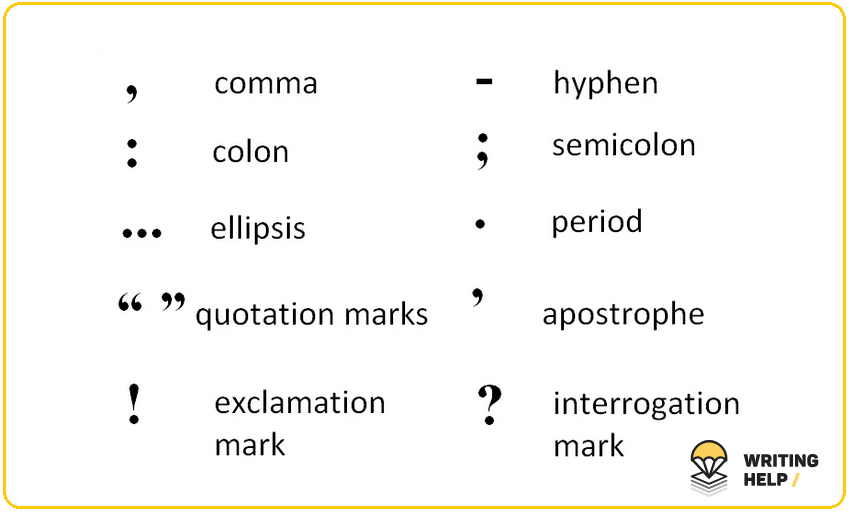
And now, to practice.
Please follow these rules for proper dialogue formatting:
- Use quotation marks. Enclose the speaker’s words in double quotations. It helps readers distinguish between a character’s speech and a narrator’s comments.
- Place punctuation inside quotation marks. All punctuation like commas, exclamations, or interrogation marks, go inside the double quotations.
- Keep dialogue tags behind quotation marks. A dialogue tag is (1) words framing direct speech to convey the context and emotions of a conversation. For example, in (“I can’t believe this is you,” she replied.), the dialogue tag is “she replied.”
- Use an ellipsis or em-dashes for pauses or interruptions. To show interruptions or pauses, end phrases with ellipses inside quotations. Em-dashes go outside quotations. No other extra marks are necessary here.
- Remember a character’s voice. Ensure that each character’s phrases reflect their background and personality.
5 More Rules to Know (+ Examples of Dialogue)
For proper formatting of dialogue in writing, stick to the following rules:
1. Each speaker’s saying comes in a new paragraph
Begin a new paragraph whenever a new character starts speaking. It allows you to differentiate speakers and make their conversation look more organized. (2)
“Has Mr. de Winter been in?” I said. “Yes, Madam,” said Robert; “he came in just after two, and had a quick lunch, and then went out again. He asked for you and Frith said he thought you must have gone down to see the ship.” “Did he say when he would be back again?” I asked. “No, Madam.” — from Rebecca by Daphne du Maurier
2. Separate dialogue tags with commas
When using dialogue tags ( e.g., “she said,” “he replied,”), separate them with commas.
For example:
“You’ve got to do something right now , ” Aaron said , “Mom is really hurting. She says you have to drive her to the hospital.” “Actually, Dad , ” said Caleb, sidling in with his catalog , “There’s someplace you can drive me, too.” “No, Caleb.” — from The Corrections by Jonathan Franzen
3. When quoting within dialogue, place single quotes
If a character cites somebody or something while speaking, we call it a reported dialogue. In this case, use single quotations within double ones you place for a direct speech. It will help readers see that it’s a quote.
John started to cry. “When you said, ‘I never wanted to meet you again in my life!’ It hurts my feelings.”
4. You can divide a character’s long speech into paragraphs
Dialogue writing is different when a person speaks for a longer time. It’s fine to divide it into shorter paragraphs. Ensure the proper quotation marks placing:
The first quotation mark goes at the beginning of the dialogue. Each later paragraph also starts with it until that direct speech ends.
The second quotation mark — the one “closing” the monologue — goes at the dialogue’s end.
Josphat took a deep breath and began. “ Here’s the things about lions. They’re dangerous creatures. They only know how to kill. Have you ever seen a lion in an open area? Probably not. Because if you had you’d be dead now. “ I saw a lion once. I was fetching firewood to cook lunch. All of a sudden I found myself face to face with a lion. My heart stopped. I knew it was my end on earth. If it wasn’t the poachers we wouldn’t be having this talk. ”
Yet, you can keep a long text as a whole by adding some context with dialogue tags. Like here:
As you can see, there’s no quotation mark at the end of the paragraph in red. It’s because the next “Ha! ha!” paragraph continues the character’s speech.
5. Use action beats
Describe actions to provide context and keep readers engaged. Help them “hear” your characters. Punctuation also helps here: exclamation (!) or interrogation with exclamations (?!) demonstrate the corresponding tone of your narrative.
He slammed the door and shouted , “I can’t believe you did that ! “
Mistakes to Avoid When Formatting Dialogue
A good dialogue is a powerful instrument for a writer to show the character’s nature to the audience. Below are the mistakes to avoid in formatting if you want to reach that goal.
So, please don’t :
- Allow characters to speak for too long. Writing long paragraphs will bore the reader, making them skip through your speech. Short but sweet talk is the best. When writing, aim to be brief, dynamic, and purposeful. If your character speaks too much, generating opinion essays , ensure this speech makes sense and serves a bigger purpose.
- Overburden dialogue with exposition. Avoid telling the story background or building sophisticated words in your characters’ speeches. Instead, reveal the narrative content in small bursts and blend it around the rest of the prose. Convey it through your character’s actions and thoughts rather than summaries and explanations.
- Create rhetorical flourishes. Make your characters sound natural. Let them speak the way they’d do if they were real people. Consider their age, profession, and cultural background — and choose lexical items that fit them most.
- Use repetitive dialogue tags. Constant “he asked” and “she said” sounds monotonous. Diversify your tags: use power verbs, synonyms, and dialogue beats.
Frequently Asked Questions by Students
How to format dialogue in an essay.
Formatting a dialogue in an essay is tricky for most students. Here’s how to do it: Enclose the speaker’s words with double quotations and start every other character’s line from a new paragraph. Stick to the citation styles like APA or MLA to ensure credibility.
How to format dialogue in a novel?
A dialogue in a novel follows all the standard rules for clarity and readability. Ensure to use attributions, quotation marks, and paragraph format. It makes your dialogue flow, grabbing the reader’s attention.
How to format dialogue in a book?
Dialogue formatting in a book is critical for storytelling. It helps the audience distinguish the hero’s words. Follow the general rules we’ve discussed above:
Use double quotations and isolate dialogue tags with commas. Remember to place the discussion in blocks for better readability.
How to format dialogue between two characters?
A two-character dialogue offers the best way to prove successful formatting skills. Ensure you use action beats, quotations, and attribution tags. It allows readers to follow the conversation and understand it better.
What is the purpose of dialogue in a narrative essay?
Dialogue writing is the exchange of views between two or more people to reach a consensus. It reveals the character’s attitude and argumentation. Last but not least, it helps convey the descriptive nature of your narrative essay.
References:
- https://valenciacollege.edu/students/learning-support/winter-park/communications/documents/WritingDialogueCSSCTipSheet_Revised_.pdf
- https://www.ursinus.edu/live/files/1158-formatting-dialogue
- Essay samples
- Essay writing
- Writing tips
Recent Posts
- Writing the “Why Should Abortion Be Made Legal” Essay: Sample and Tips
- 3 Examples of Enduring Issue Essays to Write Yours Like a Pro
- Writing Essay on Friendship: 3 Samples to Get Inspired
- How to Structure a Leadership Essay (Samples to Consider)
- What Is Nursing Essay, and How to Write It Like a Pro

- How to Punctuate Dialogue Correctly
by Russel | Jan 26, 2024 | Editing , Fiction technique

Seven essential rules for proper dialog punctuation
You’ve written some sparkling dialogue, so now it’s time to punctuate it. In this section, we’ll go through some of the main rules of dialogue formatting and punctuation.
- New speaker, new line
- Multiple paragraphs of dialogue by the same speaker
- Final punctuation (commas, periods, exclamations points)
- Single vs double quotes
- Dialog attribution tags
- Interruption in dialogue
- Pausing or trailing off
1. New speaker, new line
Each new speaker starts on a new line after a paragraph break:
“What are you doing here?” she asked. “I’m waiting for the bus; can’t you see?” “It seems a bit of a strange place to wait for a bus.” She was about to drive off when she turned and said, “Can I give you a lift?”
2. Multiple paragraphs of dialogue by the same speaker
Open each new paragraph with a quotation mark but don’t close any of them until the very last paragraph.
“I’m going to keep on talking until you really get it. Blah de blah. “This is a new paragraph and I’m still not done. “It’s still me talking but it’s midnight so I’ll stop.”
3. Final punctuation marks
If commas, full stops (periods), exclamation marks, question marks or anything else comes at the end of a passage of direct speech, they go inside the quotation marks, not outside it.
“All final punctuation goes inside the quotation marks,” he said. “Are you sure about that?” she said.
4. Single vs double quotation marks
“Should I use double quotation marks like this,” he said, ‘or single quotation marks like this?’
The choice comes down to whether you are writing in American English or UK and rest-of-the-world English. Americans tend to prefer the double quote while UK publishers generally prefer single quotes. In the end, it doesn’t matter too much which you choose as long as you are consistent.
If you want to nest quotes (a quote within a quote), use single quotes if your main text uses double, and vice versa:
“He called me a ‘wastrel and a vagabond’, but he is clearly just envious of me.”
5. Attribution tags
Dialogue attribution tags are the short statements like ‘he said’, ‘she says’ that clarify who is talking.
Tag rule 1: Don’t capitalise the first word of the tag if it comes after the words spoken.
Even if the attribution follows a punctuation mark that would normally be used to close a sentence, begin the attribution lowercase.
“Attribution tags are never capitalised,” he said. “What about after a question mark?” she said. “Even then!” he exclaimed.
Tag rule 2: If the attribution comes before the speech, use a comma or colon outside the quote marks.
He said, “Put the comma outside the quotation mark if it precedes the quote.” She looked confused: “Should I use commas or colons?”
The rules about whether to use a comma or colon differ, but generally, if the introductory phrase can meaningfully stand on its own (i.e., it’s an independent clause), use a colon. In the example above, ‘She looked confused’ makes sense all on its own, whereas ‘He said’ doesn’t. As a test, see whether a full stop would be appropriate at the end of the phrase. If so, it’s an independent clause or full sentence, so use a colon.
Tag rule 3: If attribution divides the dialogue, punctuation depends on whether the attribution lies between two full sentences or whether it breaks a sentence.
“Hello John,” said Mary. “I’m so glad you’re coming to stay.”
In the example above, the original statement consists of two sentences: “Hello John. I’m so glad you’re coming to stay.” The tag falls neatly between the sentences, so there’s a full stop after ‘Mary’. Now see what happens if we take a single sentence – “John is staying with me for two weeks” – and break it with a tag:
“John”, said Mary, “is staying with me for two weeks.”
In this example, the tag falls in the middle of a sentence, so the part after the tag continues as if the tag were not there at all, i.e., it starts lowercase and the punctuation after ‘Mary’ is a comma rather than a full stop.
Also note that the comma after ‘John’ comes outside the quote mark because the comma is not part of the original statement (“John is staying with me for two weeks”). However, this seems to be a flexible rule and might simply depend on whether the style being followed is American vs UK English. The main thing is to be consistent.
6. Interruption
To show someone’s speech being interrupted, use an em dash inside quotation marks.
“Hey, I was just thinking we should—” “Well, I’ve got a better idea.”
Note that there’s no space on either side of the em dash.
You can create an em dash on a PC by holding down the Alt key and typing 0151. On Mac, press Alt+Shift and press the hyphen/minus sign.
Em dashes can also be used to create space for a beat right inside ongoing dialogue:
“I’ve waited so long for this”—her voice broke into a sob—“and now it’s all ruined.”
7. Pausing or trailing off
Use an ellipsis (three dots) to show a character pausing mid-speech or trailing off:
“I’m wondering if we should, you know, … have another baby.” “What …?”
Ellipses at the end of a sentence don’t need a final full stop.
“I never thought I’d …”
If you type three full stops one after the other, Microsoft Word will automatically make it a single ellipsis symbol. Opinions differ on whether to put spaces on either side of the ellipsis.
“Oh, Sydney, you’re so … boring.”
“Oh, Sydney, you’re so…boring.”
Choose a style and stick to it throughout.
More dialogue-related articles
How to write authentic dialogue
The ultimate guide to fiction writing: an overview of the top 9 fiction writing skills
Get Personal Writing Support
Book assessments and author coaching.
See if your manuscript is ready for editing or publishing – order an editorial assessment with detailed feedback report and problem-solving insights.
Or choose live author coaching support with feedback on your text and regular online inspiration sessions.

Learn Fiction Writing
Book and video course.
Write Masterful Fiction: The Complete Course on Planning and Writing Stories That Publishers Love by Russel Brownlee is your all-in-one essentials course for planning and writing fiction that grabs the attention of agents, publishers and readers. Get the book or take the Udemy course and learn the core techniques of fiction while building your own story step by step. Plus – find out how to avoid the 6 common errors that will cause your manuscript to be rejected within the first few pages.
Get the Kindle or paperback on Amazon or take the video course on Udemy .

Recent Posts
- How to Edit & Proofread in Microsoft Word
- How to Become a Copy Editor in the UK (without Experience or a Degree)
- Writer’s Block: Overcoming the Perfectionism of Beautiful Writing
- How to Start Writing When You Don’t Know Where to Start
- Fiction planning
- Fiction technique
- Nonfiction planning
- Uncategorized
Free E-book
Is your manuscript ready for editing.
Find out by grabbing this 25-page report on the 7 key checks to perform before hiring an editor.
You have Successfully Subscribed!
Your privacy is important and you will not be spammed. Unsubscribe at any time.

ThinkWritten
7 Rules of Punctuating Dialogue: How to Punctuate Dialogue Easily
Learning how to punctuate dialogue is important when writing the conversations between your characters. Punctuating dialogue might not sound like a very exciting topic or a lot of fun as a writer to study – but it is very important in making sure your dialogue exchanges between characters make sense to your readers! Good punctuation…

We may receive a commission when you make a purchase from one of our links for products and services we recommend. As an Amazon Associate we earn from qualifying purchases. Thank you for support!
Sharing is caring!
Learning how to punctuate dialogue is important when writing the conversations between your characters.
Punctuating dialogue might not sound like a very exciting topic or a lot of fun as a writer to study – but it is very important in making sure your dialogue exchanges between characters make sense to your readers!
Good punctuation will help your readers connect to your characters and help you write a stronger book.
If you’ve done all of the work of planning an outline for your novel and worked on developing your characters , the last thing you want to do is lose readers by making common grammar mistakes!
How to Punctuate Dialogue
Dialogue punctuation rules are fairly straight forward and simple. Once you learn the basics of how to use punctuation in dialogue, it becomes second nature. You’ll be writing down those spoken exchanges between your fictional characters while writing your novel in no time!
In order to punctuate your dialogue correctly, it helps to understand the different parts of a sentence.
Most dialogue sentences are made of two parts: the dialogue, which is the spoken portion of the sentence, and then the dialogue tag, which identifies the speaker.
In this example, we have the following sentence, spoken by Martha.
“I am going to the zoo,” said Martha.
The sentence which Martha speaks is the dialogue . This is the part that ends with a comma. The second part is the dialogue tag . The dialogue tag is what identifies Martha as the speaker.
Now that we know this basic anatomy of dialogue sentence structure, let’s move onto the rules!
The 7 Rules of Dialogue Punctuation
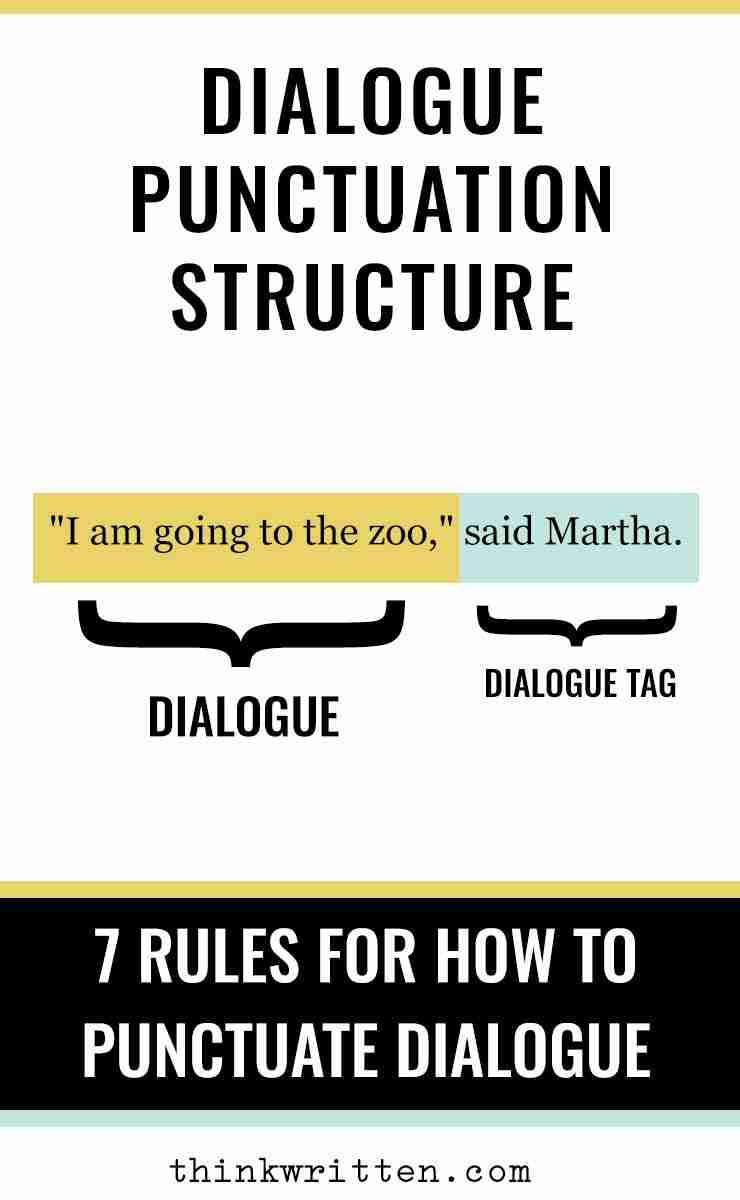
These rules are simple to follow.
Rule #1: Use Quote Marks and Commas
Surround your dialogue with quotation marks and end it with a comma before the last quote mark. End with the dialogue tag to identify the speaker.
“This is my favorite dress,” said Sally.
“I put your keys on top of the dresser,” Mark insisted.
For simple sentences, this is easy enough to remember. Now let’s get into punctuating more complex sentences!

Rule #2: Always Create a New Paragraph Line for New Speakers
When you have a new speaker, you should create a new paragraph line.
Example of Wrong Usage:
“This is my favorite dress”, said Sally. “It looks terrible on you,” said Mark.
In the example here, the two different speakers should have their own paragraphs.
Example of Proper Usage:
“This is my favorite dress,” said Sally. “It looks terrible on you,” said Mark.
Here each part of the dialogue exchange has its own individual paragraph.
Rule #3: Put Periods Inside of Quotation Marks When Not Using Dialogue Tags
When your sentence ends with a dialogue tag, you use a comma inside the quotation marks. When you are not using dialogue tags, you’ll want to put the period inside the quotation marks as well.
Incorrect Example:
Mark walked across the room to the corner dresser. “I swear I put your keys here”.
Correct Example:
Mark walked across the room to the corner dresser. “I swear I put your keys here.”
In these examples, we don’t need dialogue tags because we have already identified Mark in the paragraph. If we follow Rule #2 of always giving each character their own paragraph, we don’t have to worry about any potential confusion on who is speaking. It’s also not necessary to use a dialogue tag.
The important thing to remember for this rule is that we place the period inside the quotation marks.
Rule #4: Avoid Run-On Sentences – Use Multiple Sentences if Necessary
It’s easy to want to create run-on sentences. Fortunately, it is also easy to avoid them.
Below is an example of a run-on sentence in dialogue with way too much punctuation.
“I love this dress,” said Sally, “I’m going to wear it everywhere, not just to the wedding, but also to the grocery store, the library, and the pancake dinner.”
This above example has several mistakes in it. First of all, you should not put a comma after a dialogue tag. It’s best to use two separate sentences.
“I love this dress,” said Sally. “I’m going to wear it everywhere. I’m not just going to wear it to the wedding. I’m going to wear it to the grocery store, the library, and the pancake dinner.”
You can see in this example above we’ve actually transformed what was one giant run-on sentence into several sentences all within the quote marks.
Is this the most captivating dialogue you’ve ever read? Probably not, but it serves our example here.
Rule #5: Do Use a Comma for Action Within the Dialogue
“I love this dress,” said Sally, carefully taking it out of the closet. “I think it’s hideous,” said Mark, wondering why on earth she would want to wear something that reminded him of pea soup. “You do realize it’s the same color as pea soup, don’t you?”
In this instance, we DO use a comma, because it separates the dialogue tag from the action. In this case, Sally is doing a physical action as she takes the dress from the closet. Mark’s action is not a physical action. However, it still counts as a verb and an action all the same.
Rule #6: Know How to Punctuate Dialogue in Reverse
In all of our examples so far, we’ve put the dialogue tag at the end. However, both the dialogue tag and the action can come before the dialogue. In this case, you simply end the dialogue with a period and use a comma after the dialogue tag.
Mark whispered, “I love you even if you are wearing an ugly dress.” Looking into his eyes, Sally said, “Thank you for understanding.”
Basically, when the dialogue tag or the action comes first, you simply reverse the dialogue punctuation marks for the comma and the period.
Rule #7: Multiple Paragraphs of Same Speaker
When you have a character who is speaking a lot, it is okay if you need to use multiple paragraphs. Simply omit the end quotation mark at the end of the first paragraph and begin the second paragraph with a quote mark.
This can sometimes be confusing to readers, but there are times when it is appropriate.
“Listen, I have a lot to say about why I love this dress.” Sally straightened her posture. “This dress was my grandmother’s dress. She wore it when she first came to this country in 1936. She had nothing – no money, no food – but she had this dress. “That’s where I am today. I have nothing. Nothing! No job, no money, no car. I have this dress. It worked for my grandmother, maybe it will work for me, too. “I’m wearing this dress, and there’s nothing you can do to stop me.”
Again, sometimes it is better to break up your dialogue with different speakers or to add action – but it’s not always necessary. Largely a lot of this will depend on your own unique type of writing style , type of work you are writing and what your goals are as a writer.
Additional Dialogue Punctuation Resources
Many writers can find the task of correctly punctuating their character’s dialogue to be overwhelming. Hopefully these punctuation rules for dialogue will help you improve as a writer.
Need more dialogue writing tips? Check out our article on 6 Tips for Writing Dialogue .
You may also find that a good style manual can be a great resource to have on hand as a desk reference as a writer.
Writing dialogue punctuation does not have to be difficult. With practice and a basic understanding of these rules for when to use commas, quotation marks, and periods, you can easily add dialogue to your stories confidently.
Have any suggestions for ways you can easily remember the rules on how to punctuate dialogue? Share your tips in the comments section below!
Chelle Stein wrote her first embarrassingly bad novel at the age of 14 and hasn't stopped writing since. As the founder of ThinkWritten, she enjoys encouraging writers and creatives of all types.
Similar Posts

Tools & Resources for Writers and Authors
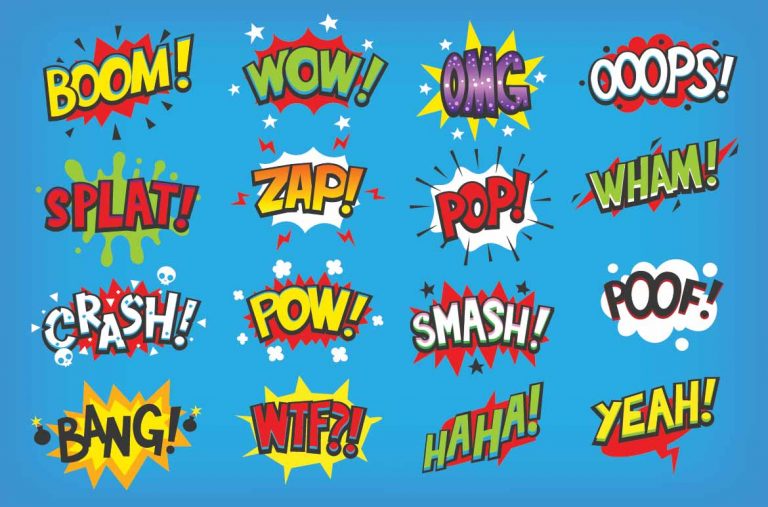
Onomatopoeia: Words List & Examples
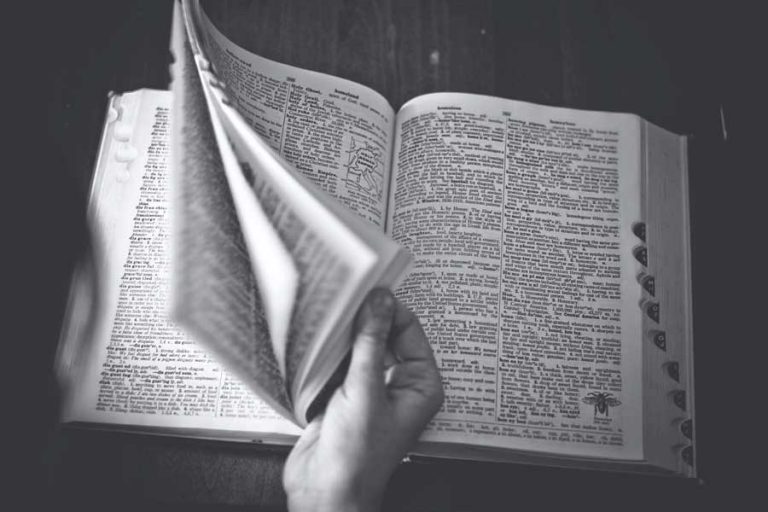
Say it Better: Using Synonyms as a Writer

How to Write a Novel: Writing a Book in 4 Steps

7 Reasons to Write Your Memoir

How to Create and Use a Writer’s Notebook
- Link to facebook
- Link to linkedin
- Link to twitter
- Link to youtube
- Writing Tips
Punctuating and Formatting Dialogue
- 5-minute read
- 2nd June 2019
Dialogue – i.e. the words spoken by characters in a story – is a vital part of fiction . And to make sure your story is a pleasure to read, you need to present the dialogue clearly. So to make sure your writing is perfect, check out our guide to punctuating and formatting dialogue in fiction.
1. Basic Punctuation and Dialogue Tags
The main way that authors mark fictional dialogue is by using quote marks . These are sometimes even known as ‘speech marks’, as they indicate that someone has said something. All you need to do in this respect is place spoken dialogue within quote marks:
‘ That is the biggest horse I have ever seen, ’ said Craig.
In British English, as shown above, we typically use single quotes marks for dialogue. However, this is largely a matter of preference in fiction, so you can also use “double quote marks”. You may have also spotted the words outside the quote marks above. This is a dialogue tag . You can use dialogue tags to show who is speaking (in this case, someone called ‘Craig’).

Something else worth noting here is that punctuation usually goes inside the closing quote mark in dialogue, even when it is not part of what someone is saying, such as the comma before the dialogue tag above. This is not always how we approach this issue in British English, since punctuation usually goes outside quote marks unless it is part of the quotation.
2. Quotes within Dialogue
If a character in your story is quoting someone else in their speech, you need to place this within quote marks as well. But to prevent confusion, you should use the opposite kind of quote marks as you use for the main quotation. For instance, if we were using single quotation marks for our main quote, we would use double quote marks for the quote-within-a-quote:
‘He called me an “ arrogant fool ” when I said I’d seen bigger horses.’
Here, we use double quote marks around ‘arrogant fool’. This shows that the speaker is quoting someone else within their dialogue.
3. New Speaker, New Paragraph
A good guideline when formatting dialogue is ‘new speaker, new paragraph’. This means that when someone new starts speaking, you set the dialogue on a new line. For instance:
Craig stared at the massive horse. ‘So huge,’ he muttered to himself. ‘What are you doing?’ asked Shannon, emerging from the farmhouse. ‘I’m watching this massive horse,’ Craig said. ‘Well, I can see that,’ Shannon said. ‘But you’ve been here for six hours, Craig.’
Find this useful?
Subscribe to our newsletter and get writing tips from our editors straight to your inbox.
In the passage above, we have dialogue from two characters. As such, we use line breaks to help the reader keep track of who is speaking, beginning a new line each time the speaker changes.
4. Formatting Long Speeches
One passage of dialogue may require multiple paragraphs. For instance, a character may be telling another character a story within a story as part of your narrative, which could involve speaking at length. And when this happens, it may not be obvious how to punctuate the dialogue.
The answer here is to use a quotation mark at the start of each paragraph when formatting dialogue. However, you will only use a closing quotation mark when the character finally finishes speaking:
Craig sighed. ‘I’ve always been obsessed with horses,’ he explained. ‘When I was a child, I spent weekends on my grandparents’ farm. But all they had were miniature ponies. And they told me that all horses were the same size. They said the ones I saw on television looked bigger because they hired tiny actors to ride them. And I believed it.
‘Or, I did until I was eighteen, anyway. That’s when I met Clayton Moore, the guy who played the Lone Ranger on TV. And he was over six feet tall, so I knew that Silver couldn’t have been as small as the ponies on my grandparents’ farm! It had all been a lie! I felt so betrayed. And ever since then, I have been looking for the biggest horse I can find.’
In the passage above, for instance, we do not use a closing quotation mark at the end of the first paragraph because it is only half way through Craig’s speech. At the end of the second paragraph, however, we use a closing quote mark to show that Craig has finished speaking.
5. Ellipses and Dashes
Finally, you can use ellipses and dashes to indicate interruptions in dialogue. There are no strict rules about how this works, but we suggest:
- Using ellipses to show that speech has trailed off (e.g. ‘I don’t know why you have a problem with…’ Craig said, before falling into silence ).
- Using an en dash or em dash to indicate speech that ends suddenly (e.g. ‘You need to take this seri–’ Shannon began, before the horse neighed loudly ).
Formatting dialogue like this will help your reader tell the difference between speech that trails off and speech that is suddenly interrupted.
Share this article:
Post A New Comment
Get help from a language expert. Try our proofreading services for free.
9-minute read
How to Use Infographics to Boost Your Presentation
Is your content getting noticed? Capturing and maintaining an audience’s attention is a challenge when...
8-minute read
Why Interactive PDFs Are Better for Engagement
Are you looking to enhance engagement and captivate your audience through your professional documents? Interactive...
7-minute read
Seven Key Strategies for Voice Search Optimization
Voice search optimization is rapidly shaping the digital landscape, requiring content professionals to adapt their...
How to Ace Slack Messaging for Contractors and Freelancers
Effective professional communication is an important skill for contractors and freelancers navigating remote work environments....
3-minute read
How to Insert a Text Box in a Google Doc
Google Docs is a powerful collaborative tool, and mastering its features can significantly enhance your...
2-minute read
How to Cite the CDC in APA
If you’re writing about health issues, you might need to reference the Centers for Disease...

Make sure your writing is the best it can be with our expert English proofreading and editing.
How do I punctuate quoted dialogue from a novel?
How you punctuate quoted dialogue from a novel will depend on what you are quoting and how you are quoting it. See the three most common considerations below.
Quoting Dialogue and Text
If you are incorporating a quotation featuring both exposition and a character’s speech into your text, use double quotation marks around the quotation and single quotation marks around the character’s speech that is within the quotation:
Early in F. Scott Fitzgerald’s The Great Gatsby , Miss Baker, upon meeting Nick Carraway, makes the first reference in the novel to the title character: “‘You live in West Egg,’ she remarked contemptuously. ‘I know somebody there’” (11).
Quoting Only Dialogue
If you quote only the speech, use double quotation marks around it:
Early in F. Scott Fitzgerald’s The Great Gatsby , Miss Baker tells Nick Carraway that he must be familiar with someone she knows from West Egg: “You must know Gatsby” (11).
Using Block Quotes
When quoting dialogue from a novel, set the quotation off from your text as a block if each character’s speech starts on a new line in the source. Indent the extract half an inch from the left margin, as you would any block quotation. If a character’s speech runs onto a new line, as it does below, indent each line of dialogue an additional half an inch. Use double quotation marks around the spoken words :
Early in F. Scott Fitzgerald’s The Great Gatsby , Miss Baker tells the narrator, Nick Carraway, that she knows someone from his town: “You live in West Egg,” she remarked contemptuously. “I know somebody there.” “I don’t know a single–” “You must know Gatsby.” “Gatsby?” demanded Daisy. “What Gatsby?” (11) Work Cited Fitzgerald, F. Scott. The Great Gatsby. Scribner, 1953.
How To Format Dialogue (includes examples)

Choosing a Pen Name
When I learned that a half-dozen other authors using variations of my real name had books in print, I decided I needed a pen name.

Creative Ways To Capture Research Notes
When my research for my novel-in-progress required hiking in freezing weather, taking notes the traditional way didn’t work well. Here’s a couple of ideas of how to use technology for even better results.

How To Write Engaging Dialogue
I’ve spent years honing my dialogue writing skills. Here are some of the steps I use to make my dialogue natural and engaging.

Plot Planning for Novels
After abandoning my third rewrite of my novel, I decided the time had come for some serious plot planning. Here’s what worked for me.
Join Our Newsletter
Join our newletter to receive the latest writing and storytelling tips and techniques.
Thank you for joining!
Join our list.
Get notified by email when new information is published.
You have Successfully Subscribed!
Pin it on pinterest.
8 Essential Rules for Punctuating Dialogue - article
Dialogue is a critical component to a great book: it drives action; it reveals character; and it relays facts and information. Writing realistic, compelling dialogue takes skill and practice—and so does punctuating it correctly. Dialogue has its own set of rules that can be tricky to keep straight. Here are eight essential rules for punctuating dialogue correctly, so that your text communicates clearly and appears polished and professional.
1. Use a comma to introduce text
When writing dialogue, place a comma before your opening quote. There is, however, an exception to this rule: no comma is needed when you introduce text using a conjunction, such as that or whether .
She said, "It's all in the details."
He told me that "there are 1,008 different reasons to write."
2. Use a comma when a dialogue tag follows a quote
While your character may have just spoken a complete sentence, you may not need to end it with a period. When dialogue is followed by a tag (for example, he said, asked, replied ), then use a comma before the closing quote when you would normally use a period. If no tag follows the text, end the dialogue with punctuation to end the spoken sentence. This rule applies only to periods. You should not omit other punctuation that adds meaning or clarity to the sentence, such as an exclamation point or question mark.
"Let go of your fears," he replied.
"Write from your heart," she stated. "It's the best way to reach the reader."
"When is the best time to write?" she asked.
"Now!" he answered.
3. Periods and commas fall within closing quotations
When closing a quotation, a period or comma always falls within the quotation, not outside of it.
"All of these rules are starting to make sense."
"It's a matter of practice," he said.
She explained, "You just need to understand each rule."
4. Question marks, exclamation points, and dashes fall inside or outside closing quotations
In dialogue, question marks, exclamation points, and em dashes typically fall within closing quotation marks. However, it depends on the usage and meaning. These punctuation marks may fall outside of the closing quotation mark in some cases.
"Four!" he shouted, as he whacked the ball off the tee.
Congratulations to "the man who has it all"!
"Are you joining us today?" she asked.
Which book contains the phrase, "It was the best of times, it was the worst of times"?
She said, "I can do this"— and that's when she began her career in writing.
5. Use single quotes when using quotes within dialogue
Use a pair of single quotes nested within doubles to indicate quoted text within dialogue. Note that there is no added space in between the closing single and double quotation mark.
"When doling out dessert, my grandmother always said, 'You may have a cookie for each hand.'"
He said, "I've heard that this one is 'the phone for the next generation,' but I'm not sold on it yet."
6. Use capitalization to indicate the end of the sentence
When writing dialogue, only capitalize the first letter of a word to indicate the end of the sentence. There may be times when you end the quote with punctuation that would normally require the next word to be capitalized, such as an exclamation point or question mark. But unless the sentence is truly over, use a lowercase letter to follow this punctuation.
"He's here! He's here!" she screamed.
"Would you like to answer the door?" she asked.
"What do you mean," he said to Jenna, "by asking me to dinner?"
7. Use paragraph breaks to indicate a change in speaker
In dialogue, a new paragraph is used each time there's a change in speaker. This helps with clarity and can eliminate the need to add tags after each line of dialogue. Here's an example from A Tale of Two Cities :
"You know the Old Bailey well, no doubt?" said one of the oldest of clerks to Jerry the messenger.
"Ye-es, sir," returned Jerry, in something of a dogged manner. "I do know the Bailey."
"Just so. And you know Mr. Lorry?"
"I know Mr. Lorry, sir, much better than I know the Bailey. Much better," said Jerry, not unlike a reluctant witness at the establishment in question, "than I, as a honest tradesman, wish to know the Bailey."
8. When in doubt, look it up
The rules for punctuating dialogue are established for the sake of clarity. Follow the rules, and you can communicate your message clearly to your reader. You can find more details and examples to special cases in The Chicago Manual of Style . Also, rely on a good copy editor to help you catch any errors in dialogue punctuation you may have missed.
- E. Claire</a> likes this" data-format="<span class="count"><span class="icon"></span>{count}</span>" data-configuration="Format=%3Cspan%20class%3D%22count%22%3E%3Cspan%20class%3D%22icon%22%3E%3C%2Fspan%3E%7Bcount%7D%3C%2Fspan%3E&IncludeTip=true&LikeTypeId=00000000-0000-0000-0000-000000000000" >

Top Comments
You have given petty good tips on punctuation which is not known by many students. I am preparing my own articles now and your tips and tutorials are helpful in framing my sentences with good grammar.
intresting im only 11 yrs old and im intrested
- olivia</a> likes this" data-format="{count}" data-configuration="Format=%7Bcount%7D&IncludeTip=true&LikeTypeId=00000000-0000-0000-0000-000000000000" >
I often have doubts, especially when I need to use punctuation in my gothic narratives, where there are sounds and screams which I have to render by text and then incorporate the general idea of fear and awe. I was a business writer a couple of years ago, so it's a drastic change for me in fiction
Quite helpful, thank you!
© Copyright 2018 Author Learning Center. All Rights Reserved
- Features for Creative Writers
- Features for Work
- Features for Higher Education
- Features for Teachers
- Features for Non-Native Speakers
- Learn Blog Grammar Guide Community Events FAQ
- Grammar Guide
How to Punctuate and Format Inner Dialogue

The ProWritingAid Team

Inner dialogue is an excellent way to give your readers a peek inside the heart and mind of your characters. Readers can’t get this depth of character strictly from the actions you include in your story. You should give them inner thoughts to create 3-D characters with which your readers will fall in love.
We have an excellent article, What’s She Thinking? How to Use Inner Dialogue , that will give you a more in-depth understanding of the mechanics of using inner dialogue.
Now let’s talk about how to format inner dialogue.
The Bad News
There is no hard and fast rule about formatting inner dialogue. Depending on which author, editor, or publisher you talk to, there are as many ways to handle inner dialogue as there are people writing it.
The one thing that needs to be pointed out, however, is that you shouldn’t use quotation marks for inner dialogue. The majority of experts agree that punctuation should be reserved for regular dialogue because it would get too confusing for your reader to try to figure out if the character is thinking or actually saying it out loud.
The Good News
Formatting inner dialogue is a stylistic choice, for the most part. Here are 3 different ways you can handle it, depending on what you’re trying to do with the inner dialogue.
1) Use both italics and thought dialogue tags . Combining italics with thought tags is a clear and definite signal to your reader that your character is thinking something. Consider the following example:
- Geneva bent down to pick up the sliver of metal. What could this possibly be from? she thought.
Your reader wouldn’t misconstrue what you have in mind here, so if you need it to be readily apparent that you’re inside a character’s head, this is the method to use.
2) Use italics without thought dialogue tags . A lot of authors nowadays use italics to denote inner dialogue, like Stephen King. I think he is one of the most adept authors out there at writing compelling inner dialogue. So if he uses italics, so do I.
- Geneva bent down to pick up the sliver of metal. What could this possibly be from?
3) Use neither italics nor thought tags . If you want the least intrusive way to present your character’s thoughts that won’t pull your reader’s attention away from the words on the page, use this method. Compare this to the other examples listed above:
Further examples for effect
Depending on the method you choose to punctuate, you can bring your reader closer in with the least amount of narrative distance. Here are 3 examples that have very different effects:
Margaret watched the man amble over to her side of the bar. He looks nothing like my usual choice of male companions , she thought. I should’ve never made eye contact. (Use this to give your reader some distance if you’re using an omniscient third-person narrator who can see inside everyone’s thoughts.)
Margaret tilted her head as the man ambled over to her at the bar. He looks nothing like what I’m interested in. She glanced around quickly. Is there anyone else I can talk to instead of this man? (This gets your reader a little closer to your character.)
Margaret saw with some alarm that the man was making his way to her side of the bar. Damn, why did I make eye contact? She jerked her head around, trying to find someone else to talk to. Maybe he’ll go away if he sees me talking to another man.
See how the third method keeps the reader firmly inside Margaret’s head with nothing to break the focus? There’s nothing to signal to your reader that something else is going on besides what you want them to know. The reader is firmly inside your character’s head at this point.
Imagine the impact the third method would have if you were using first-person narration. Your reader would be inside your main character’s head. Good stuff.
I started to hyperventilate when I saw him grab his beer and head my way. Damnit, why did I make eye contact? I searched desperately around the bar. I’ve got to find someone else to talk to so this guy goes away.
Final thoughts
Again, it’s a stylistic choice how you punctuate your inner dialogue. Just make sure you’re consistent. Whatever method you choose, stick with it throughout your novel. Using various methods will frustrate your reader, the last thing you want to do.
Love grammar? Check out our Grammar Rules Blog and these great posts from our archive:
- What’s She Thinking? How to Use Inner Dialogue…
- Infographic: What are Homophones, Homographs, and Homonyms?
- What is a Cliché? And Why Should You Avoid Them?
- What are the Different Types of Verbs?
- What are Overused Words?
- What is a Clause?
- Hyphen, En Dash & Em Dash: Do You Know the Difference?
- MLA Format: Headings to Citations

Be confident about grammar
Check every email, essay, or story for grammar mistakes. Fix them before you press send.
The most successful people in the world have coaches. Whatever your level of writing, ProWritingAid will help you achieve new heights. Exceptional writing depends on much more than just correct grammar. You need an editing tool that also highlights style issues and compares your writing to the best writers in your genre. ProWritingAid helps you find the best way to express your ideas.
Get started with ProWritingAid
Drop us a line or let's stay in touch via :

IMAGES
VIDEO
COMMENTS
Rule #8: Use Em-Dashes and Ellipses to Interrupt Speech. If you need to indicate an interruption in dialogue due to being cut off or a pause in speech, then you will use an em-dash or ellipses within the quotation marks. For example: "I know you care a lot about him, but — ".
6 essential dialogue punctuation rules: 1. Always put commas and periods inside the quote. 2. Use double quote marks for dialogue (if you're in America) 3. Start a new paragraph every time the speaker changes. 4. Use dashes and ellipses to cut sentences off.
Mary asked, tears in her eyes. "Because I love you.". However, if the dialogue tag breaks a sentence in half, put a comma after the tag, then open the quotation marks with a lowercase letter (unless it is a proper noun). "Listen, Linda," Mr. Graves said, "you've done a great job, but I have to let you go.".
Look through the following 11 scenarios with their rules and examples to better understand punctuation for each dialogue situation you're likely to face. 1. Action Beats. Let's start with the distinction between two things often confused with each other: Dialogue tags — like "they said". Action beats — like "they laughed/smiled ...
1. Begin and end with quotation marks. Your dialogue should start and end with quotation marks. Quotation marks show your reader when a character is speaking and they separate speech from the rest of the text. Related: 31 Common Grammar Mistakes (With Examples and Corrections) 2. Use a dialogue tag.
Keep dialogue tags behind quotation marks. A dialogue tag is (1) words framing direct speech to convey the context and emotions of a conversation. For example, in ("I can't believe this is you," she replied.), the dialogue tag is "she replied.". Use an ellipsis or em-dashes for pauses or interruptions.
On Mac, press Alt+Shift and press the hyphen/minus sign. Em dashes can also be used to create space for a beat right inside ongoing dialogue: "I've waited so long for this"—her voice broke into a sob—"and now it's all ruined.". 7. Pausing or trailing off.
8 tips for creating engaging dialogue in a story. Now that you've mastered the mechanics of how to write dialogue, let's look at how to create convincing, compelling dialogue that will elevate your story. 1. Listen to people talk. To write convincingly about people, you'll first need to know something about them.
Start Using Dialogue Tags. Anytime someone says something, use quotation marks around what they say, and usually, you need to use dialogue tags. The tag indicates who said what. Here are some examples. Wrong: "Good morning.". Right: "Good morning," my boss said. There's no need to fear dialogue tags.
Rule #1: Use Quote Marks and Commas. Surround your dialogue with quotation marks and end it with a comma before the last quote mark. End with the dialogue tag to identify the speaker. "This is my favorite dress," said Sally. "I put your keys on top of the dresser," Mark insisted.
Here, we use double quote marks around 'arrogant fool'. This shows that the speaker is quoting someone else within their dialogue. 3. New Speaker, New Paragraph. A good guideline when formatting dialogue is 'new speaker, new paragraph'. This means that when someone new starts speaking, you set the dialogue on a new line.
your essay. , The Comma The comma is one of the most important pieces of punctuation in academic writing but is often the most overused and misused. A typical sentence should contain one or two commas. If you have more than three, you might want to consider breaking your sentences down into smaller parts.
Dialogue punctuation has its own rules and can make or break the professionalism of your work. We've got the basics that'll have you punctuation dialogue like a pro.
Internal dialogue can tell the reader what a character is thinking. It can provide deep insight into a character's thoughts, fears, self-esteem, and general point of view. For that reason, internal dialogue is one of the most important tools at an author's disposal, as it can provide a rich, three-dimensional rendering of a character.
Dialogue makes the story dynamic, enlivens the characters, and moves the action along unobtrusively. However, the guidelines governing how to arrange and punctuate dialogue can be confusing. This handout demystifies the technical aspects of writing dialogue. Using the Symbols The open end of a quotation mark should face the words of the dialogue.
Using Block Quotes. When quoting dialogue from a novel, set the quotation off from your text as a block if each character's speech starts on a new line in the source. Indent the extract half an inch from the left margin, as you would any block quotation. If a character's speech runs onto a new line, as it does below, indent each line of ...
1. Enclose the spoken words with double quotation marks. "I love it when that happens.". Note: The British use single quotation marks. 2. Dialogue tags (the he asked/she said portions) stay outside the quotes and get separated by a comma. Sam said, "I'll never do that again.". "Don't be a sissy," said Bill.
Dialogue has its own set of rules that can be tricky to keep straight. Here are eight essential rules for punctuating dialogue correctly, so that your text communicates clearly and appears polished and professional. 1. Use a comma to introduce text. When writing dialogue, place a comma before your opening quote.
Dialogue in an essay can be implemented when writing fiction or nonfiction narrative work. As an example, working with (or citing) movies, plays, books or reports, its usage may even become obligatory for greater effect. However, one should not mistake dialogue with academic research necessity to directly quote from journals, books or any other ...
Written by MasterClass. Last updated: Aug 30, 2021 • 4 min read. Whether you're working on a novel or short story, writing dialogue can be a challenge. If you're concerned about how to punctuate dialogue or how to format your quotation marks, fear not; the rules of dialogue in fiction and nonfiction can be mastered by following a few ...
Formatting inner dialogue is a stylistic choice, for the most part. Here are 3 different ways you can handle it, depending on what you're trying to do with the inner dialogue. 1) Use both italics and thought dialogue tags. Combining italics with thought tags is a clear and definite signal to your reader that your character is thinking ...
Poetry (and really, what are songs but sung poetry?) can be punctuated or unpunctuated, but the removal of the punctuation is a stylistic choice, not a necessary one. I've read quite a bit of poetry that was punctuated normally. And then I've read E. E. Cummings. Since the author chose to punctuate the lyrics, I would leave the punctuation in.
Colleagues reportedly called Lucy Letby an "angel of death," and the Prime Minister condemned her. But, in the rush to judgment, serious questions about the evidence were ignored.